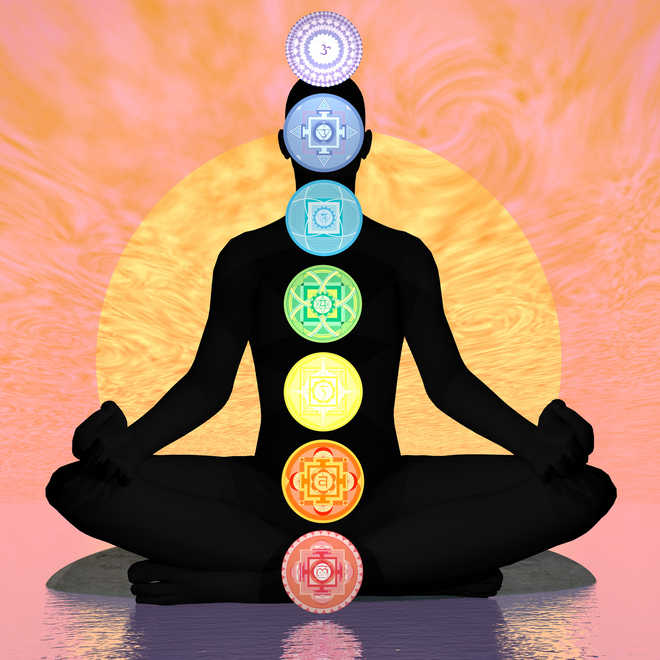Dr Satish K Kapoor
Human body is energy cloaked in matter. Chakras are centres of the etheric body that receive prana, life-energy, from the cosmos through the medulla oblongata for distribution among various organs of the physical body. The tantric-yoga tradition speaks of seven principal chakras (lit. wheel or disk): muladhara, root-chakra, svadhishthana, sacral-chakra, manipura, solar plexus-chakra, anahata, heart-chakra, vishuddha, throat-chakra, ajna, brow-chakra, and sahasrara, crown chakra. The first five chakras are located along the spinal cord. The last two are associated with the pineal gland, and the cranium at the top of the head, respectively.
Each chakra corresponds to an organ of body, a nerve plexus or an endocrine gland. Each is related to a primal element, a deva and a devi – male and female aspects of divinity, a colour, a planet, a zodiacal sign, a gemstone, and an animal, in terms of its peculiar configuration and traits.
Chakras and sound
Chakrass are allegorically represented as lotuses, having a different number of petals with Sanskrit letters inscribed on them. These letters are concretized sound-vibrations that emanated from Shiva’s damru while he was performing the cosmic dance. Each chakra is loaded with the mystic power of a bija mantra, seedsound, that can be amplified by external chanting of the same. The distinctive notes of a raga, musical melody, awaken them to full life. Muladhara is roused by Shri Raga, svadhishthana, by Vasanta, manipura by Bhairavi, anahata by Panchama, and vishuddha by Megha. The last two chakras are charged by the primordial sound, Aum.
Kundalini shakti
Kundalini shakti is the coiled-up energy that lies dormant at the base of the spinal column. Chakras are psychic junctions of innumerable nadis or astral tubes (72,000, according to Hatha Yoga Pradipika, III.116) through which the energy travels, from muladhara, the lowest centre of consciousness symbolizing Shakti to sahasrara, the highest centre, symbolising Shiva. Kundalini is roused by antahkarana shuddhi, purification of instruments of cognition, asana, physical postures, pranayama, breath control, bandhas, physical locks, hasta-mudras, hand gestures, mantras, and meditation.
Spiritual ascension
As long as the mind is engrossed in issues of survival and of enjoyment, one is stuck up in the lower three chakras, and remains unaware of the higher dimensions of life. When consciousness rises up to anahata chakra, it imbues a person with feelings of love, which may take any shape — animal, human or divine — depending on one’s sanskaras, mental impressions, temperament, circumstances, daily company, and inner wisdom. At the level of throat-chakra, associated with space or ether, feelings get spontaneous expression.
When consciousness ascends to ajna chakra – seat of the mind and the soul — that marks the confluence of three main psychic channels – ida, pingala and sushumna, the dynamics of spirituality unfold in a mysterious way, rendering one the divine ability to go beyond ordinary states of the mind. One perceives divine light and listens to the unstruck sound, losing worldly consciousness. Ajna chakra is the doorway to higher spiritual regions. As concentration deepens, one is able to control prana, operating in all the six chakras below, and reach shunya-mandala, circle of the eternal void, popularly called, sahasrara-dala- padma, ‘thousand petal-lotus’. Here, the indissoluble unity of Shiva and Shakti is realised, and one savours amrita, the divine elixir.
Turiya-kundalini
According to Agamic works, kundalini shakti undergoes three phases during the course of its ascension: from muladhara to anahata, it is agni or fire kundalini; from anahata to ajna, it is surya or sun- kundalini; and from ajna to sahasrara, it is chandra or moon-kundalini. The highest form is turiya-kundalini, in which one is elevated to the fourth dimension of being, characterized by spiritual purity, peace and bliss.
(Dr Kapoor is a noted educationist,
historian and spiritualist)









